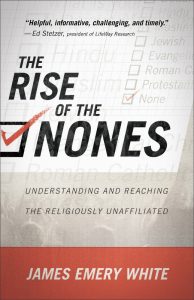
White, James Emery. The Rise of the Nones: Understanding and Reaching the Religiously Unaffiliated. Grand Rapids: Baker Books, 2014. 221 pp.
American culture is shifting, becoming more secular, pluralistic, and ultimately less religious than in previous generations. Since the 1990s, people are disassociating themselves with formal religious groups, choosing instead the “none of the above” option for their religious affiliation. What does this mean for society? How should evangelization strategies and evangelism methods adjust to these changes? In his book, The Rise of the Nones, James Emery White, pastor of Mecklenburg Community Church in Charlotte, North Carolina, and former President of Gordon-Conwell Theological Seminary, addresses these questions, arguing that the rise of the “nones” indicates a significant cultural transformation that requires Christians and local churches to reevaluate their understanding of society and alter their approach to evangelism and church.
Summary
White organizes his work into two sections, each addressing a specific aspect of his investigation into the “nones” (i.e., individuals unaffiliated with religious organizations). Section one (chapters 1-5) describes the recent growth of the “nones,” including their rise, characteristics, relationship to current culture, and beliefs (7). Section two (chapters 6-13) outlines “the new mentality and approach” necessary to evangelize this growing group (8). In addition, White includes two appendices that are lectures he gave addressing some “key concerns [of] the nones” (8, italics in original).
Those considering themselves “nones” are neither anti-religious nor irreligious, but are indifferent toward religion, though many consider themselves spiritual. As such, they are not “seekers” looking for something, but instead they dislike labels, groups, and formal institutions, and thus are not looking for these in their lives (ch. 2).
White shows that since the 1990s “nones” have been “the nation’s fastest-growing and second-largest religious category,” experiencing unprecedented growth (17). He attributes this to a “perfect storm” created by the church’s recent activities and failures. “Nones” view the church as greedy and morally bankrupt (37), politically motivated (37-39), and abrasively confrontational, judgmental, and hypocritical (39-41).
Furthermore, White states that there are three “cultural keys to the rise of the nones”: “secularization, privatization, and pluralization” (46-51, italics in original). Christianity ceased being the dominant worldview and the shaper of culture (“secularization”); religion and faith were segregated from public discourse and expression, relegating it to personal opinion (“privatization”); and absolute truth was abandoned in favor of equality of all faiths (“pluralization”).
Because of their cultural and religious views, “nones” are not looking for religion, and when approached with religion, they express indifference and disinterest. As a result, traditional methods of outreach, which are built on the premise that society overall holds certain religious views, are no longer effective. A new paradigm, new strategies, and new evangelism methods are required to reach “nones.”
White argues in section two that churches must undergo a “paradigm shift” regarding the type of growth sought (73). They must focus more on conversion growth, less on consumer-driven methods of doing church, and discover the needs of the “nones” without adulterating the gospel (ch. 6). Previous outreach methods, he argues, ultimately target transfer growth, not conversions. He then outlines six “atmospheres” found in churches as they relate to “nones”: “none hostile,” “none indifferent,” “none hopeful,” “none sensitive,” “none targeted” (the ideal), and “no man’s land” (ch. 7).
In order to reach the “nones,” White states that churches must incorporate three changes. First, they must adopt one or more “causes” (a social problem that the church can address, cf. ch. 8). Second, the church must reemphasize “grace and truth” (ch. 9). Regarding grace and truth, he lists four possible approaches: no grace, no truth (e.g., karma); grace without truth (e.g., tolerance, universalism); truth without grace (e.g., Islam, legalism); and grace with truth (i.e., the cross and Christ). Third, the church must return to Christian intellectual thought and scholarship within churches rather than offer feel-good theology and emotion-driven faith (ch. 10). This requires adopting “new apologetics” that focus less on empirical arguments and more on applicational and relational questions, i.e., the “so what” question (131-33).
White outlines two requisites to adopting these changes. First, there must be unity between Christians (ch. 11). Unity is not “uniformity” or “unanimity,” but is “being kind to one another, gracious to one another, forgiving of one another—not assuming the worst, shooting the wounded, or being quick to be suspicious” (144-45). Second, the church must “open its front doors” to the “nones” (ch. 12). White describes five keys to creating this open door: “friendliness,” “children’s ministry,” “music,” “buildings,” and “visuals.”
He concludes his work with a discussion on the primacy and centrality of the church for reaching the “nones” (ch. 13). Although they reject institutions and labels, Christ established the church as the sole instrument through which his followers are to reach the world with the gospel. He further states that in the New Testament no ministry or evangelistic endeavor occurred outside of the church.
Critical Evaluation
This evaluation will answer two key questions: (1) did White precisely identify and characterize the “nones” and their impact on culture, and (2) did he clearly outline a method to reach them? Through the use of voluminous surveys and research studies in section one, White analyzes the personality, beliefs, and demographics of the religiously unaffiliated. Furthermore, he shows that their recent growth is shifting American culture to the point that, if the church desires to reach them, new mindsets and approaches are necessary.
Despite his overwhelming evidence identifying “nones,” there are areas wherein White does not adequately support his claims. First, he attributes the rise of the “perfect storm” to an assortment of attention-grabbing headlines, small social movements, and fads of the 1990s. He argues that these contributed to the secularization of society, shifting its attention away from religion and toward self-interest and entertainment. However, he does not show how these shifts are more radical or influential than the headlines, uprisings, and shifts of other era such as the 1960s (34-36). Are these headlines a cause or effect? Are they the early stages of a disease or the consequential symptoms?
Second, in his presentation of the “nones” and the resulting cultural shift, White does not address a likely resistive pushback: “this isn’t true in my community.” There will be some who reject the idea that society has changed significantly or that the old approaches must be reevaluated, modified, or abandoned. Nevertheless, by referencing numerous surveys and cultural studies, White successfully analyzes “nones” and their impact on evangelistic strategies, showing that the church must adapt how it evangelizes if it desires to reach this growing group.
White follows his analysis of the “nones” with an adequate attempt to outline methods to reach them. Section two includes some useful—and much needed—information, though its usefulness is limited. One of the book’s strengths is that White reminds his readers of the importance of focusing on conversion growth rather than transfer, biological, or prodigal growth (ch. 6). Also, he clearly articulates the error of some of the traditional methods of outreach (e.g., offering things that other churches do not), brilliantly illustrating it with car sales; he equates much of the current outreach methods to offering cars to people not in the market for cars (76-79).
As for specific application, four of White’s recommendations are noteworthy. First, he calls on churches to return to an emphasis on Christ and the cross (i.e., “grace and truth,” ch. 9). Second, he recommends adopting an intellectual “new apologietics” emphasizing application and meaning more than empiricism rather than emotional-based faith and religious self-help lessons (ch. 10). Third, he emphasizes the necessity of unity among believers (ch. 11). Finally, he offers five keys to creating a church welcoming to “nones,” showing how each addresses their needs and apprehensions (ch. 12).
[bctt tweet=”@JamesEmeryWhite’s #RiseoftheNones offers insight into a phenomenon that’s never been seen in USA.” username=”jrothra”]
Despite these strengths, the impact of section two is significantly diminished due to various weaknesses. In chapter seven, White discusses six “atmospheres” but only clearly defines two: “none hostile” and “none indifferent.” The two that receive the greatest emphasis, “none targeted” (the ideal) and “no man’s land,” are left ambiguous. As such, White does not give the reader a rubric by which to categorize their church, despite asking he reader to make such a determination (98, question 5).
Second, White calls on churches to adopt a “cause” in order to appeal to the social concerns of “nones.” However, in his discussion of “cause”—a social issue that the church can address—his lack of clarity opens the door to misinterpretation. He advises churches to engage in social improvement as a means to appeal to the “nones” and implement God’s kingdom, which he inadequately attempts to distinguish from social transformation or social justice. As a result, White opens the door to adopting social justice, the social gospel, and religious progressivism.((John L. Rothra, “Progressivism’s Impact on Evangelism: The Confluence of Ideas Between Woodrow Wilson and John R. Mott, and Barack Obama and Jim Wallis” (PhD dissertation, Southwestern Baptist Theological Seminary, 2014).))
Third, although he rightly instructs churches to emphasize “grace and truth,” he does not clearly define “truth”; the closest he comes is to define it negatively (ch. 9). White refers to truth as rules and regulations imposed by man, citing Islam as a prime example (though he also references Christian legalism). With this being the only definition, one is left wondering what “grace and truth” entails. Does it mean preaching both the cross and imposing legalistic rules? White leaves this unanswered.
Finally, despite application comprising most of the book, White overlooks two vital areas: small churches and submission to God. At times he calls for changes not all churches will know how to make, such as changing music styles (including different instruments), building renovations, and implementing multimedia. However, he fails to help smaller churches understand how to make these adjustments. How will a small country church of fifty people with an average age of 65 implement these changes? Will this require first seeking transfer, prodigal, or biological growth, which is contrary to White’s argument? Such guidance for small churches is absent.
Not only does White overlook small churches, he also overlooks submission to God. There is no chapter or specific discussion on submission to the Holy Spirit, the supremacy of Christ, or the sovereignty of God. Similarly, there is only a limited discussion on sin, especially pride (the hurdle to change); the closest he comes is a few paragraphs of a subsection (83-84). None of the proposed changes are possible without any of these. Pride prevents Christians from fully appreciating the changing nature of society, and it prevents submission to the Triune God. Unless one submits to God, it is unlikely the necessary paradigm shift will occur and unity will never be achieved.
Conclusion
James Emery White’s work, The Rise of the Nones, has the potential to be groundbreaking, especially section one, wherein he analyzes and characterizes the rising group of the religiously unaffiliated, the “nones.” However, its usefulness in application is hindered by limited elaboration (e.g., “causes”), undefined terms (e.g., “truth”), and overlooked vital details (i.e., small churches and submission to God). As such, White accomplishes most, but not all, of his stated goal.
Nevertheless, when viewed as an exposé of current culture, The Rise of the Nones offers insight into a modern phenomenon that has been never before seen in American culture. He shows that unlike past generations, the “nones” are indifferent to religion and do not approach the world from a Christian—or even a Christian-influenced—worldview. For that reason alone, White’s work is pivotal to both understanding culture and devising new strategies to reach that culture.














